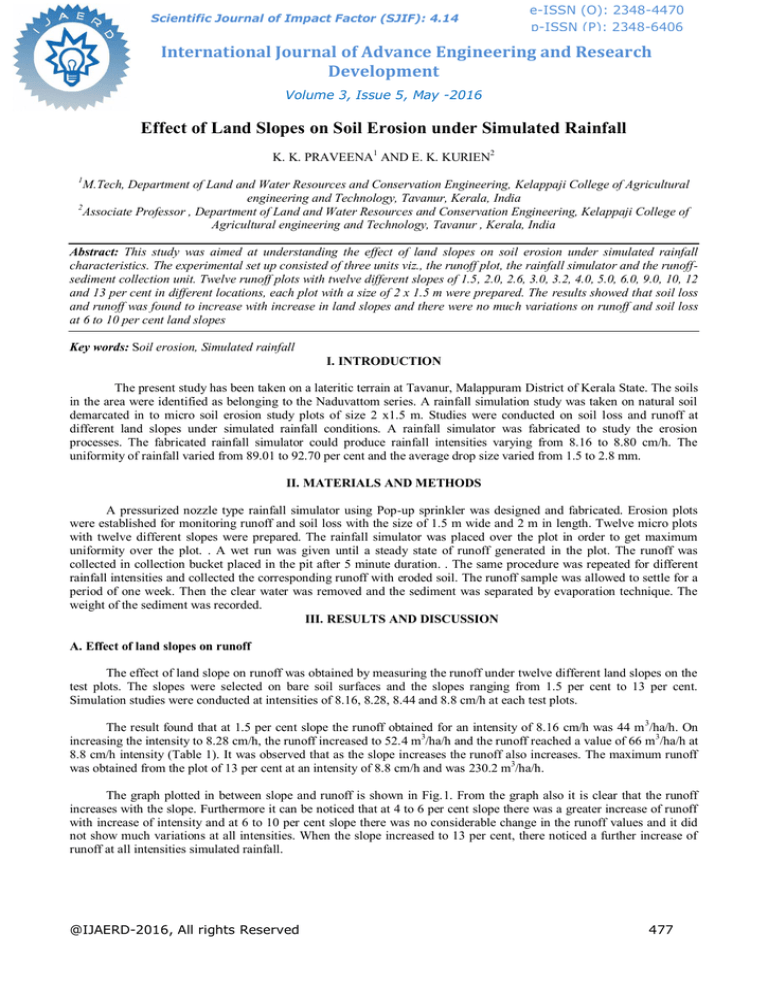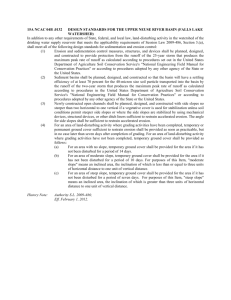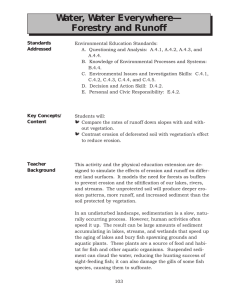
Scientific Journal of Impact Factor (SJIF): 4.14
e-ISSN (O): 2348-4470
p-ISSN (P): 2348-6406
International Journal of Advance Engineering and Research
Development
Volume 3, Issue 5, May -2016
Effect of Land Slopes on Soil Erosion under Simulated Rainfall
K. K. PRAVEENA1 AND E. K. KURIEN2
1
M.Tech, Department of Land and Water Resources and Conservation Engineering, Kelappaji College of Agricultural
engineering and Technology, Tavanur, Kerala, India
2
Associate Professor , Department of Land and Water Resources and Conservation Engineering, Kelappaji College of
Agricultural engineering and Technology, Tavanur , Kerala, India
Abstract: This study was aimed at understanding the effect of land slopes on soil erosion under simulated rainfall
characteristics. The experimental set up consisted of three units viz., the runoff plot, the rainfall simulator and the runoffsediment collection unit. Twelve runoff plots with twelve different slopes of 1.5, 2.0, 2.6, 3.0, 3.2, 4.0, 5.0, 6.0, 9.0, 10, 12
and 13 per cent in different locations, each plot with a size of 2 x 1.5 m were prepared. The results showed that soil loss
and runoff was found to increase with increase in land slopes and there were no much variations on runoff and soil loss
at 6 to 10 per cent land slopes
Key words: Soil erosion, Simulated rainfall
I. INTRODUCTION
The present study has been taken on a lateritic terrain at Tavanur, Malappuram District of Kerala State. The soils
in the area were identified as belonging to the Naduvattom series. A rainfall simulation study was taken on natural soil
demarcated in to micro soil erosion study plots of size 2 x1.5 m. Studies were conducted on soil loss and runoff at
different land slopes under simulated rainfall conditions. A rainfall simulator was fabricated to study the erosion
processes. The fabricated rainfall simulator could produce rainfall intensities varying from 8.16 to 8.80 cm/h. The
uniformity of rainfall varied from 89.01 to 92.70 per cent and the average drop size varied from 1.5 to 2.8 mm.
II. MATERIALS AND METHODS
A pressurized nozzle type rainfall simulator using Pop-up sprinkler was designed and fabricated. Erosion plots
were established for monitoring runoff and soil loss with the size of 1.5 m wide and 2 m in length. Twelve micro plots
with twelve different slopes were prepared. The rainfall simulator was placed over the plot in order to get maximum
uniformity over the plot. . A wet run was given until a steady state of runoff generated in the plot. The runoff was
collected in collection bucket placed in the pit after 5 minute duration. . The same procedure was repeated for different
rainfall intensities and collected the corresponding runoff with eroded soil. The runoff sample was allowed to settle for a
period of one week. Then the clear water was removed and the sediment was separated by evaporation technique. The
weight of the sediment was recorded.
III. RESULTS AND DISCUSSION
A. Effect of land slopes on runoff
The effect of land slope on runoff was obtained by measuring the runoff under twelve different land slopes on the
test plots. The slopes were selected on bare soil surfaces and the slopes ranging from 1.5 per cent to 13 per cent.
Simulation studies were conducted at intensities of 8.16, 8.28, 8.44 and 8.8 cm/h at each test plots.
The result found that at 1.5 per cent slope the runoff obtained for an intensity of 8.16 cm/h was 44 m 3/ha/h. On
increasing the intensity to 8.28 cm/h, the runoff increased to 52.4 m3/ha/h and the runoff reached a value of 66 m3/ha/h at
8.8 cm/h intensity (Table 1). It was observed that as the slope increases the runoff also increases. The maximum runoff
was obtained from the plot of 13 per cent at an intensity of 8.8 cm/h and was 230.2 m3/ha/h.
The graph plotted in between slope and runoff is shown in Fig.1. From the graph also it is clear that the runoff
increases with the slope. Furthermore it can be noticed that at 4 to 6 per cent slope there was a greater increase of runoff
with increase of intensity and at 6 to 10 per cent slope there was no considerable change in the runoff values and it did
not show much variations at all intensities. When the slope increased to 13 per cent, there noticed a further increase of
runoff at all intensities simulated rainfall.
@IJAERD-2016, All rights Reserved
477
International Journal of Advance Engineering and Research Development (IJAERD)
Volume 3, Issue 5, May -2016, e-ISSN: 2348 - 4470, print-ISSN: 2348-6406
B. Effect of land slopes on soil loss
From the experiments it was found that at an intensity of 8.16 cm/h the soil loss from 1.5 per cent slope was 10.8
kg/ha/h, whereas the value increased to 50.3 kg/ha/h for 2 per cent slope. At a higher intensity of 8.8 cm/h, the soil loss
from the plot of 1.5 per cent slope was 40.8 kg/ha/h while it was 300 kg/ha/h when slope was increased to 13per cent
(Table 1). A general trend of increase in the soil loss with the slope is seen from whole observations.
Higaki et al. (1999) reported the similar results in his study, that surface erosion rate on laterite slopes was
increased with increase of slope. Kinnell (2000) noticed that sediment concentration in flow from side slopes increased
with slope gradient, particularly if this exceeded 10per cent. However, studying erosion from small plots with slope
gradients of 4per cent and 8 per cent in tilled fields, Chaplot and Bissonnais (2003) reported that sediment concentration
in runoff was not correlated with slope gradient. In his study, Suhua Fu (2009) found that the total soil loss was increased
with slope, and then decreased after a maximum value was reached. He also indicated that the slope gradient has greatest
effect on down slope soil erosion and least impact on lateral erosion.
A graph was plotted in between slope and soil loss as shown in Fig. 2. From the graph it can be seen that there
was a considerable increase of soil loss at 1.5 to 2 per cent slope at all intensity of simulated rainfall and then the soil loss
decreased at 3 to 5 per cent slopes. The soil loss at 6 to 10 per cent slope was found to be without any noticeable
differences. This may be due to the fact that the observed runoff at 6 to 10 per cent slope was almost similar. Ben-Hur,
(2006) also showed the same results that for the mild slopes of five per cent and nine per cent, the sediment concentration
is stable, which could characterize either a transport limited or a detachment limited process. And after that the graph
showed that the soil loss again increased to its maximum level at the maximum slope of 13 per cent at each application of
intensity of simulated rainfall.
Table 1. Effect of land slope on runoff and soil loss
Intensity(cm/hr)
8.80
8.44
8.28
8.16
8.80
8.44
8.28
8.16
8.80
8.44
8.28
8.16
8.80
8.44
8.28
8.16
8.80
8.44
8.28
8.16
8.80
8.44
8.28
8.16
8.80
8.44
8.28
8.16
8.80
8.44
8.28
8.16
Slope (%)
1.5
@IJAERD-2016, All rights Reserved
2.0
2.6
3.0
3.2
4.0
5.0
6.0
Runoff (m³/ha/h)
66.0
56.8
52.4
44.0
70.0
68.0
60.0
46.8
92.6
88.0
86.8
80.4
96.0
92.2
75.2
74.0
102.0
92.8
88.0
84.6
109.6
93.2
86.0
82.0
180.6
172.4
168.5
166.2
192.6
188.8
178.2
170.3
Soil loss (kg/ha/h)
40.8
21.2
14.0
10.8
70.8
63.1
54.8
50.3
74.4
38.4
32.4
24.4
80.6
78.2
56.3
48.2
120.0
98.0
86.0
58.0
120.6
102.7
98.4
67.6
120.8
101.6
99.2
62.4
132.2
128.9
110.4
80.2
478
International Journal of Advance Engineering and Research Development (IJAERD)
Volume 3, Issue 5, May -2016, e-ISSN: 2348 - 4470, print-ISSN: 2348-6406
8.80
8.44
8.28
8.16
8.80
8.44
8.28
8.16
8.80
8.44
8.28
8.16
8.80
8.44
8.28
8.16
9.0
10.0
12.0
13.0
160.0
80.0
40.0
40.0
180.0
140.0
60.0
40.0
228.0
164.8
123.2
84.8
300.0
160.0
130.0
84.8
Runoff (m3/ha/h) Vs Slope(%)
250
Runoff (m³/ha/h)
198.2
189.7
179.6
170.3
206.0
176.6
160.0
150.0
206.4
198.3
197.4
166.5
230.2
218.6
207.8
202.5
200
8.8 cm/h
150
8.44 cm/h
8.28 cm/h
100
8.16 cm/h
50
0
0
2
4
6
8
10
Slope (%)
Figure. 1. Effect of landslope on runoff
12
14
Soil loss (kg/ha/h) Vs Slope(%)
350
soil loss (kg/ha/h)
300
250
8.8 cm/h
200
8.44 cm/h
150
8.28 cm/h
100
8.16 cm/h
50
0
0
2
4
6
8
10
12
14
Slope (%)
Figure. 2. Effect of landslope on soil loss
@IJAERD-2016, All rights Reserved
479
International Journal of Advance Engineering and Research Development (IJAERD)
Volume 3, Issue 5, May -2016, e-ISSN: 2348 - 4470, print-ISSN: 2348-6406
IV. REFERENCES
[1] Agassi, M. and Bradford, J.M. 1999. Methodologies for interrill soil erosion studies. Soil and Tillage Res. 49:
277-287.
[2] Ben-Hur, M. and Agassi, M. 1997. Predicting interrill erodibility from measured infiltration rate. Water Resour.
Res. 33: 2409–2415.
[3] Chaplot, V.A.M. and Bissonnais, Y. L. 2003. Runoff features for interrill erosion at different rainfall intensities,
slope lengths, and gradients in an agricultural loessial hillslope. Am. J. Soil Sci. Soc. 67: 844–851.
[4] Fernandez, G. J., Barahona, E. and Mingorance, M. D. 2008. Measurement of infiltration in small field plots by
a portable rainfall simulator: application to trace-element mobility. Water Air Soil Poll.191: 257–264.
[5] Humphry, J.B., Daniel, T.C., Edwards, D.R. and Sharpley, A.N. 2002. A portable rainfall simulator for plotscale runoff studies. Appl. Eng. Agric. 18: 199–204.
[6] Kinnell, P.I.A. 2000. The effect of slope length on sediment concentrations associated with side-slope erosion.
Am. J. Soil Sci. Soc, 64p.
[7] Kinnell, P.I.A. 2005. Raindrop-impact-induced erosion process and prediction: a review. Hydrol. Process.
19:2815–2844.
[8] Mingyong Z., Shuduan T., Haishan D. and Quanfa Z. 2012. Rare earth elements tracing the soil erosion
processes on slope surface under natural rainfall. Journal of Environmental Radioactivity. 102 (12):1078-1084.
[9] Ries, J. B., Thomas, I. and Manuel, S. 2013. Small scale rainfall simulators: Challenges for a future use in soil
erosion research. In: Geophysical Research Abstracts, Vol. 15. Trier University, Physical Geography, Trier,
Germany.
[10] Sajeena, S., Abdul Hakkim, V. M. and Kurien, E. K. 2013. Erodibility and Runoff Potential of Three Well
Defined Series of Laterite Soils in Kerala under Simulated Rainfall Conditions. Int. J. Eng. Res. and Dev. Vol.
8, pp. 42-48.
[11] Veena, U. J. and Devidas, T. T. 2010. Estimation of infiltration rate, run-off and sediment yield under simulated
rainfall experiments in upper Pravara Basin, India: Effect of slope angle and grass-cover. J. Earth Syst. Sci. 119
(6): 763–773.
[12] Verbist, K., Cornelis, W. M., Gabriels, D., Alaerts, K. and Soto. G. 2009. Using an inverse modelling approach
to evaluate the water retention in a simple water harvesting technique. Hydrol. Earth Syst. Sci. 13:1979-1992.
[13] Whisenant and Steve, G. 2008. Terrestrial systems. In: Perrow, M. R. and Davy, A.J (eds), Handbook of
Ecological Restoration: Principles of Restoration. Cambridge University Press, p. 89.
[14] Xinxiao Y., Xuexia Z., Jianlao L., Manliang Z. and Yuanyuan X. 2006. Effects of vegetation cover and
precipitation on the process of sediment produced by erosion in a small watershed of loess region. Acta
Ecologica Sinica. 26(1): 1-8.
[15] Zachar and Dusan. 1982. Classification of soil erosion. In: Soil Erosion. Vol. 10, Elsevier, 48p.
@IJAERD-2016, All rights Reserved
480



